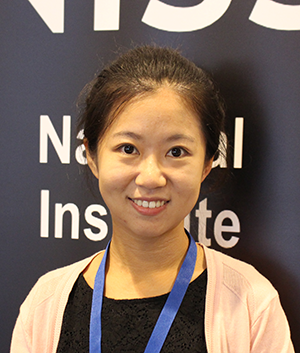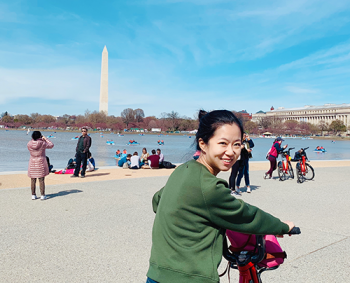

Strong Interest in Math Started Early
My parents always told me that when I grow up, I should give back to the society. In high school I was very interested in numbers and formula and math was the one subject I was very good at! As a result, at Nankai University, one of the top three math departments in China, I chose mathematics as my undergraduate major. During those four years, I developed a very solid background in mathematics, however, pure math is far from its application in real life. For this reason, I decided to continue my studies in statistics when I went to the United States. The stories hidden in numbers are so attractive to me! As a PhD student at Worcester Polytechnic Institute, in Worcester, Massachusetts studying applied statistics I knew that if I could discover and tell people the true stories hidden in numbers, I can give back something.
I feel very confident when I am dealing with numbers and I am eager to learn and discover new methods to tell the hidden story accurately and efficiently.
All of the modeling analysis and the uncertainty that exists around the real-world problems attracts me. As a master's degree student my research focused on financial problems. We tried to investigate quadrinomial methods to provide good approximations to the true asset option value. As a result, I realized that I needed to study more about statistics. I lacked a solid background in statistics and also the research skills that I needed. After I graduated with a master's degree in finance I went to Worcester Polytechnic Institute (WPI) for a PhD in Applied Statistics.
Doctoral Studies in Statistics
During my first two years at WPI I took the fundamental advanced statistics courses. But then a Bayesian statistics course provided me another new look into the world. The theory of Bayesian statistics is about “updating people’s belief in the evidence of new data”, and this is exactly how human beings think and deal with problems every day. I decided that my PhD research would be on Bayesian statistics. Specifically, my PhD thesis is in Small Area Estimation. I tried to borrow information from other resources (data), areas and subareas to provide model-based estimates of people’s health status in Nepal. These methods can help to capture and predict a small area's characteristics of interest without spending a lot in survey. Findings such as these can help policy makers to make decisions in funding.
Connecting with NISS
I worked as a NISS-NASS (the National Agricultural Statistics Service) summer intern back in 2015 for three months. That was the first time I was able to get involved in so many real-world projects. At the end of 2018, NISS was seeking a PhD in small area estimation. This was my research interest and my expertise! So I applied and gave a presentation about hierarchical Bayesian logistic regression modeling for subareas at NASS and received very good feedback. After I graduated from WPI I became a NISS research associate in early 2019.
Currently, I am mainly focused on the research related to the crops county-level estimates project by using small area estimation modeling. I am working with a number of experienced statisticians at NASS. Right after I joined the NISS-NASS team in February, they had just received the field office reviews of county estimates project. The field office report provided many insights and opinions on how to improve the project. The big challenge at that time was about incorporating inequality constraints into the model. My job was to study and investigate models with constraints and to provide reliable and reasonable model estimates at the county level. It has been wonderful to work within such a talented group of statisticians.
The real world is real world. It is not like it is back in school!
I came to NASS with little background knowledge about agriculture and the County Agricultural Production Survey (CAPS) and the different sources of data used in this project. I collaborate from different aspects with a wide range of team members. Our work has been productive. We received the On-The-Spot award during July at NASS. In fact, as NASS transitioned to a system of model-based crops county estimates, I have interacted with leadership and staff across the nation to implement and improve upon production-worthy data products.
Projects as a Sources of New Learning
I have also been involved in the Data Visualization Completion at the US Department of Agriculture using Tableau. While I had no experience using Tableau before I joined NISS, during the research on county estimates project I found Tableau is a very easy-to-use tool for data visualization and presentation. I now use it to detect outliers, abnormal patterns and make comparisons between models very easily. I worked with Irwin Anolik at NASS to create a Tableau dashboard about the Census of Agriculture from 2017 in order to participate in the Visualization Challenge competition. I spent a lot to extra time in learning and investigating how to make an effective and beautiful dashboard that tells the stories of data. We won the Rookie of the Year award!
I have been involved in different data sources: survey, administrative data, remote sensing data, geographic and weather data. There are many challenges in how to combine them to provide reliable estimates. Missing data, constraints among different estimates and outliers are three big issues I am dealing with right now. For example, the county-level harvested acres estimates cannot exceed the planted acres estimates and cannot negative as well. Before fitting and developing models, I need to think more on the reality. The estimates from modeling must make sense.
My NISS experience has been fantastic! I can apply what I learned during my PhD to a real-world project. I keep learning new things every day and continue to hope that I can give back something based on my expertise along the way.
